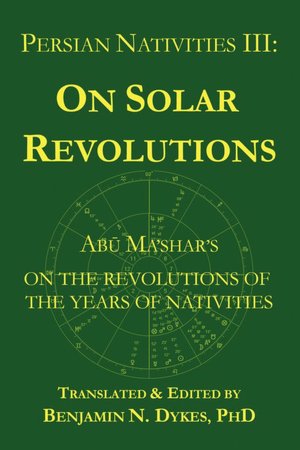
This is the third volume in the series of “Persian Nativities,” which center on translations of the writings of 8th to 10th century Persian astrologers. While these books are one thousand years old or more, these dudes were crackerjack astrologers who knew their business. The methods are more-or-less Hellenic Astrology 3.0. There’s less focus on triplicity rulers, and much more on sign rulers and the bounds (or terms) of axis and planetary placements, and a mix of Lots.
Abu Ma’shar (born in 787 CE, died 886) was introduced to astrology by the famous al-Kindi, and went on to become one of the shining lights of the Persian astrological community and a prolific writer. Much of his work was translated into Latin, making him a significant contributor to medieval astrological practices.
The book featured in Persian Nativities III sets forth a combination of forecasting methods that was standard practice in his times. While these include methods culled from earlier Hellenic practices, the layers of annual charts and time lords described in this book appears to be a culmination of hundreds of years of practical work by astrologers picking and choosing what was most effective for supplying forecasts for clients.
The various layers include the annual profection and solar revolution (aka solar return), and the longer-term time lords—the distributor and partner, and firdariyyat lord and sub-lord. Dykes and Abu Ma’shar provide comprehensive instructions on how to use these methods to make effective predictions for the client.
This is a highly useful text, and highly recommended for the excellence of both the presentation and the techniques described. Any astrologers seeking clear how-to instructions on Persian methods would be well-advised to acquire this book.
~review by E. Hazel
Translated and edited by Benjamin N. Dykes, Ph.D.
Cazimi Press, 2010
